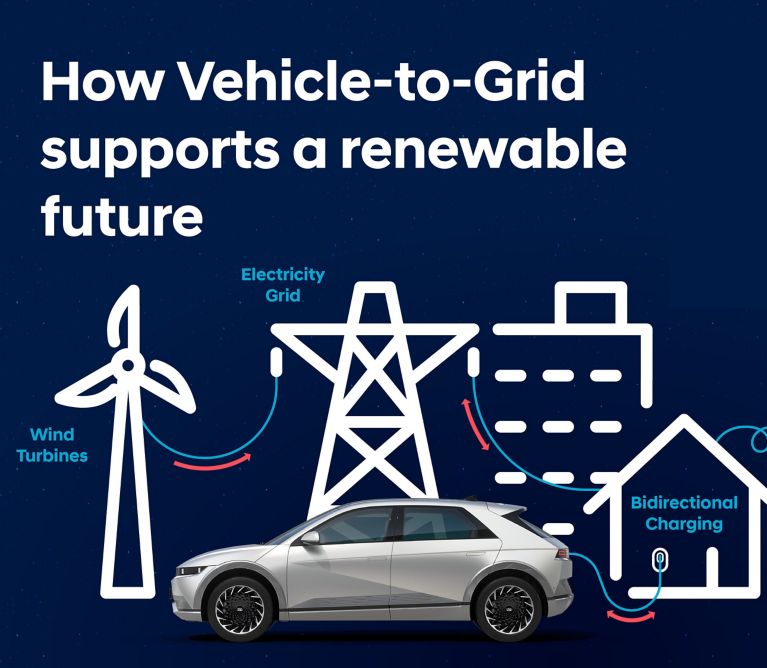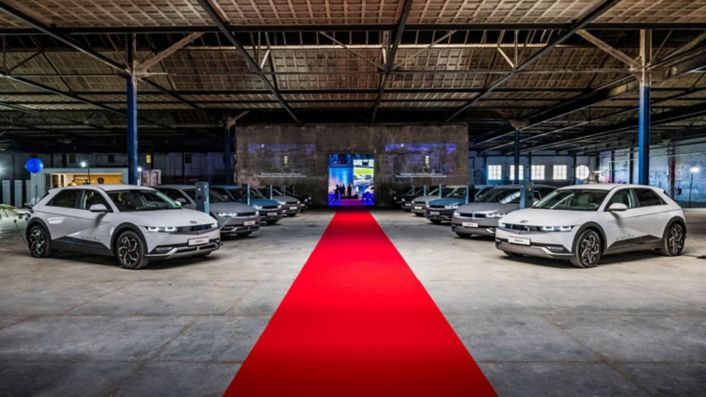- EVs that are equipped with innovative Vehicle-to-Grid (V2G) technology can serve as a storage unit for renewable energy
- In leveraging renewable energy stored in EV batteries and feeding back to grid at peak times, V2G technology generates benefits for EV owners and entire societies
- Hyundai Motor projects in the Netherlands and Germany share a glimpse into the promising future of V2G technology
According to a recent assessment by the European Environment Agency, up to 80 per cent of cars in the EU will be fully-electric by 2050. With EV ownership continuing to rise, there will be a rapid increase in the number of zero-emission cars on our roads in the next decade alone.
While the transition to renewable energy is certainly a positive one for the environment, this drastic transformation will nevertheless bring with it a series of challenges to consumers, communities and the stability of local electricity grids.
To support the transition to renewable energy, innovative Vehicle-to-Grid (V2G) technology offers a potential solution. V2G can leverage the renewable energy stored in EV batteries and feed it back to the grid at peak times, benefiting EV owners and entire societies.
Challenges caused by the shift to renewable energy
The first challenge to consider is the shift to more EVs on the roads that will require the use of more renewable energy. This is already a common social phenomenon: the spike in energy demand that is instantly created when people wake up in the morning and switch on their kettles, or cook an evening meal while watching television after work.
Secondly, lower power-plant utilisation rates will inevitably lead to higher operational costs. This will result in increased electricity rates for consumers, as well as potential price spikes.
Thirdly, although the level of fossils fuels used to generate electricity is slowly falling – decreasing from 39 per cent in 2019 to 37 per cent in 2021 – the carbon intensity of energy creation must be much further reduced.
Finally, countries all over the world still need to increase their capacity to generate and accommodate sufficient energy to meet this new demand.
To tackle these challenges and ease the shift towards renewable energy, EV batteries could offer a very efficient solution for intelligent energy storage and distribution.
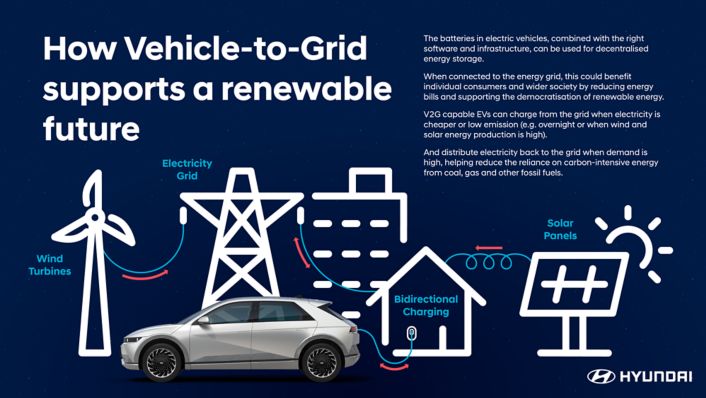
How can Vehicle-to-Grid technology help?
Vehicle-to-Grid (V2G) technology is an innovative concept that is being developed to take advantage of this opportunity. Eventually, this technology could be a key feature that all EVs are equipped with. Hyundai as one of the leading manufacturers is making considerable progress in this field.
V2G technology allows power grids to cope with the incremental load from charging millions of EVs, while at the same time better integrating more intermittent renewables into the system. EVs that are equipped with V2G technology can serve as a storage unit for renewable energy.
In a grid system, EV batteries supported by V2G technology can be used as a buffer whenever required. Vehicles can feed renewable energy back into the grid during times when solar or wind power cannot be generated, such as on a calm evening. Similarly, during peak times, when large amounts of energy are being consumed, EVs can supply electricity back to the grid to balance demand.
V2G technology will give EVs a secondary purpose outside of passenger transportation. Their energy can be fed back to the grid to be used by local energy distribution utilities, while their batteries can also then be used for storing energy, helping energy distributors to stabilise the grid. As well as managing energy supply during peak times and helping to decarbonise the power system, this technology even has the potential to create financial benefits for drivers and grid distributors, as well as delivering a significant benefit for the environment by supporting the decarbonisation of the power grids.
In the following video, Nicki Shields, an automotive journalist and EV expert explains how V2G technology works, and highlights the technology’s and societal benefits.

Societal benefits of V2G technology
In addition to providing benefits for EV owners, as infrastructure to support V2G technology is further developed and rolled out, the technology also has the potential to bring advantages to society as a whole, local energy grids and the environment.
When wind turbines or solar panels produce more electricity than the grid requires, EVs that are V2G-capable can be used to store the excess electricity. Therefore, V2G technology could play a major role in managing the energy supply in the future.
As well as supporting the stabilisation of the local grid, V2G technology will also contribute to the reliable provision of renewable energy. On the supply side, the democratisation of renewable energy is already here. But with V2G technology, there is now the potential to achieve this on the demand side, too.
On average, most cars remain parked and stationary for 96 per cent of the time, or over 23 hours a day, while daily journeys usually only require around one-tenth of an EV’s battery capacity for actual driving1. Having charged their vehicles at a lower cost during off-peak hours, EV owners can sell the unused energy in their EV batteries during peak hours when electricity is scarce, and its price is higher. This way, EV batteries can be used as a source of flexible and low-carbon energy to support grid stability. This saves important grid capacity and reduces operational costs for energy providers.
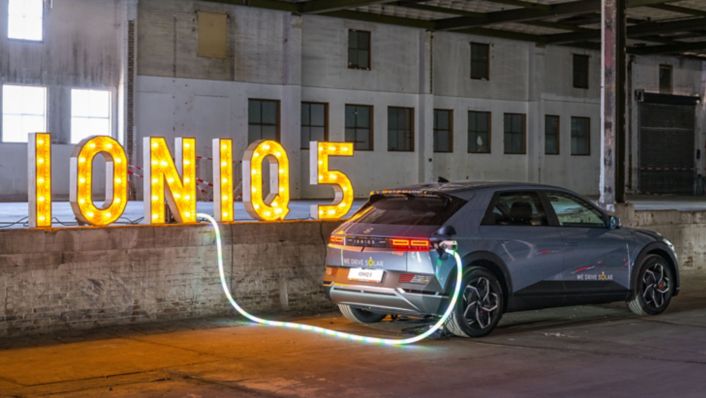
The future of V2G
V2G is a future-proofed technology that is already available now. Reorganisation of the grid – which requires cooperation with a range of stakeholders, including governments, energy providers and OEMs – is already taking place. In addition, a common protocol for communication between EV and grid is being established.
A single EV can store enough electricity to supply up to five households for 24 hours2. An entire fleet could have a significant impact on entire towns and cities, with the ability to take advantage of excess renewable energy during the middle of the day and offset peak morning and evening grid demand. Thanks to the V2G technology, cars will not only be able to supply energy to the grid, but also to customers’ homes.
To make all of this possible and encourage the further rollout of V2G technology, further development of business models, studies about commercial feasibility, and consideration of regulatory issues is necessary.
Mass adoption of V2G requires strong changes and continued development
However, encouraging the mass adoption of V2G will require strong buy-in and behavioural changes from consumers, as well as the continued development and digitalisation of power grids and increased collaboration between ecosystem participants such as governments.
While V2G on a big scale may not come to fruition at scale for a number of years, it is a solution that has the potential to offer many benefits for consumers in the future, especially at a time of energy scarcity and rising energy prices, and as the sales of EVs continues to grow.
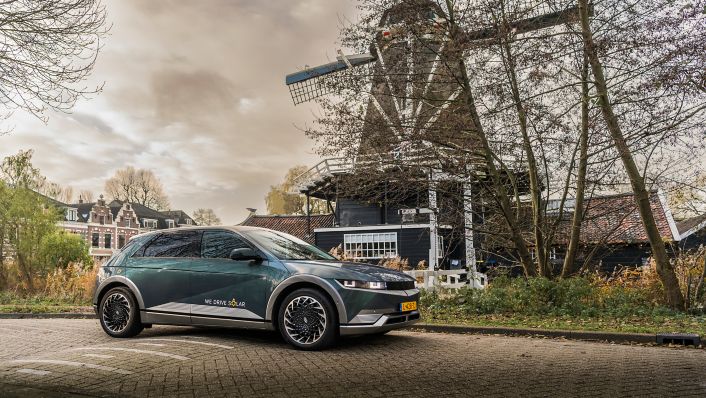
V2G projects in the Netherlands and Germany
Hyundai is always looking for societal solutions to support its Progress for Humanity vision and goal for carbon neutrality in Europe by 2035. In Europe, the company is already putting V2G technology into practice. Working with partners in the fields of energy provision and technology, it has established two key pilot projects in the Netherlands and Germany.
The Dutch city of Utrecht is aiming to develop the world’s first bi-directional region. Here, Hyundai is working together with local mobility operator We Drive Solar by deploying a fleet of IONIQ 5 units for a new mobility service powered by V2G technology.
We Drive Solar's ambition is to realise the large-scale application of V2G with a fleet of hundreds of bi-directional shared IONIQ 5 units in Utrecht, and later in other cities in Europe. To this end, we are building the largest factory of bi-directional charging stations in Europe and we are working closely with Hyundai to enable the scaling up of the bi-directional ecosystem.
Meanwhile, in Germany, Hyundai is collaborating with Next Kraftwerke, which operates as a ‘middle-man’ between those who have energy provision and the grid.
During the pilot in Germany, we were able to use the installations to test the technical feasibility of a future V2G service. The goal was to prequalify Hyundai Motor Group's e-vehicles and provide secondary control power (SRL). With this asset, we were able to bundle the cars together as a virtual power plant and participate in the energy market.
These pilot projects help Hyundai understand more about the kind of technical requirements that are required to enact V2G at scale by presenting a potential solution to balancing the supply and demand of local grids. They also demonstrate how new entrants to the energy market can be supported, as well as how communities can be empowered to benefit from zero-carbon energy sources.
1 https://todaytimeslive.com/technology/162027.html
2 Calculation based on estimated consumption of 10-15 kWh per day per household of four people (without an EV and solar panels), with individual households powered sequentially. V2G technology is subject to continuous monitoring and research with the aim to ensure accuracy of measurements of its parameters. However, the actual process of powering a household with energy from a V2G EV depends on applied technical solutions, location-specific conditions and energy consumption profile and may differ from above calculations.
Disclaimer: CO2 and emissions data
- Electricity consumption combined for the Hyundai IONIQ 5 58 kWh with 2WD in kWh/100 km: 16.7; CO2 emissions combined in g/km: 0 (WLTP)
- Electricity consumption combined for the Hyundai IONIQ 5 58 kWh with 4WD in kWh/100 km: 18.1; CO2 emissions combined in g/km: 0 (WLTP)
- Electricity consumption combined for the Hyundai IONIQ 5 77.4 kWh (19” alloy rims) with 2WD in kWh/100 km: 17.0; CO2 emissions combined in g/km: 0 (WLTP)
- Electricity consumption combined for the Hyundai IONIQ 5 77.4 kWh (20” alloy rims) with 2WD in kWh/100 km: 18.0; CO2 emissions combined in g/km: 0 (WLTP)
- Electricity consumption combined for the Hyundai IONIQ 5 77.4 kWh (19” alloy rims) with 4WD in kWh/100 km: 17.9; CO2 emissions combined in g/km: 0 (WLTP)
- Electricity consumption combined for the Hyundai IONIQ 5 77.4 kWh (20” alloy rims) with 4WD in kWh/100 km: 19.1; CO2 emissions combined in g/km: 0 (WLTP)

